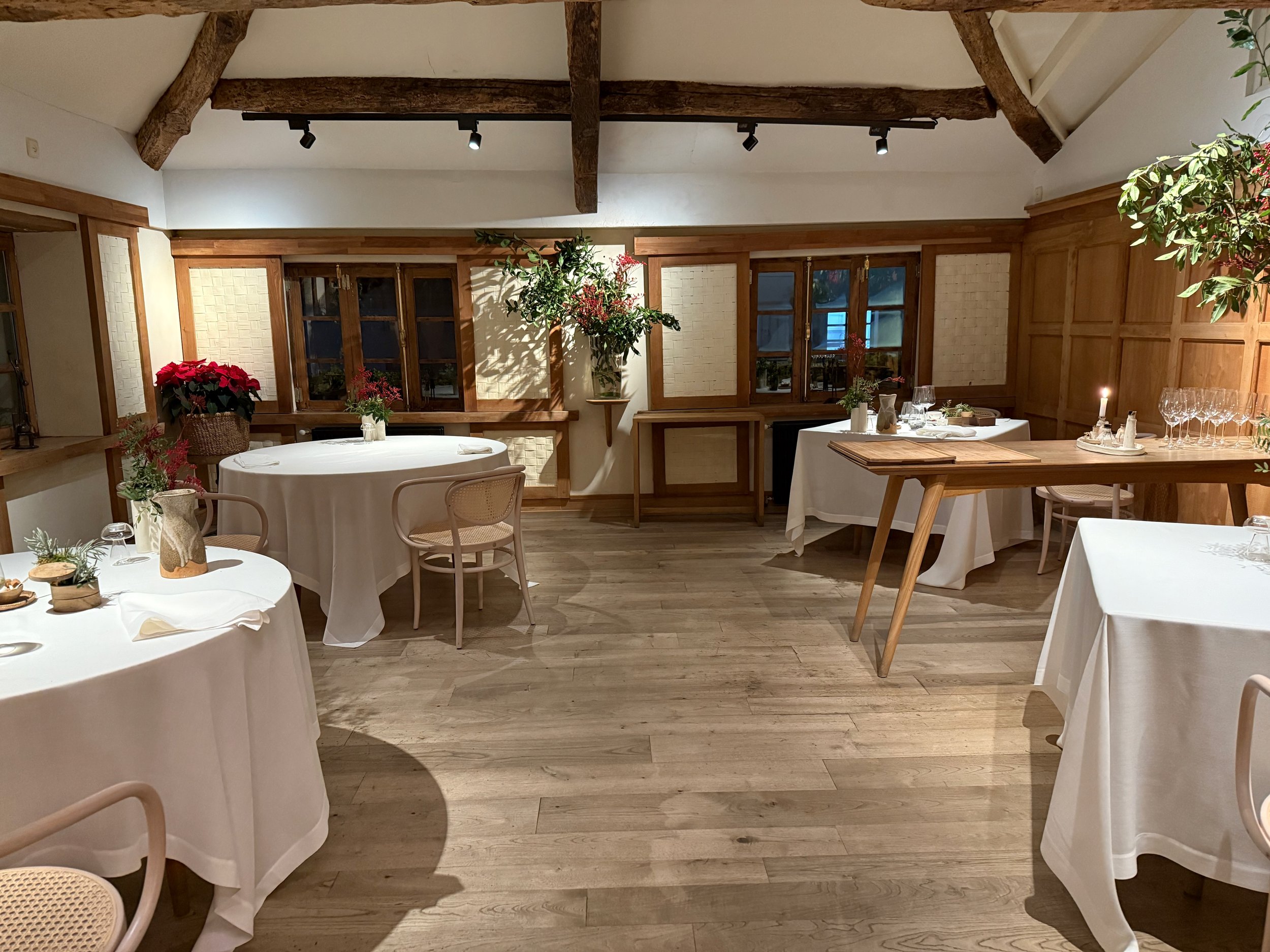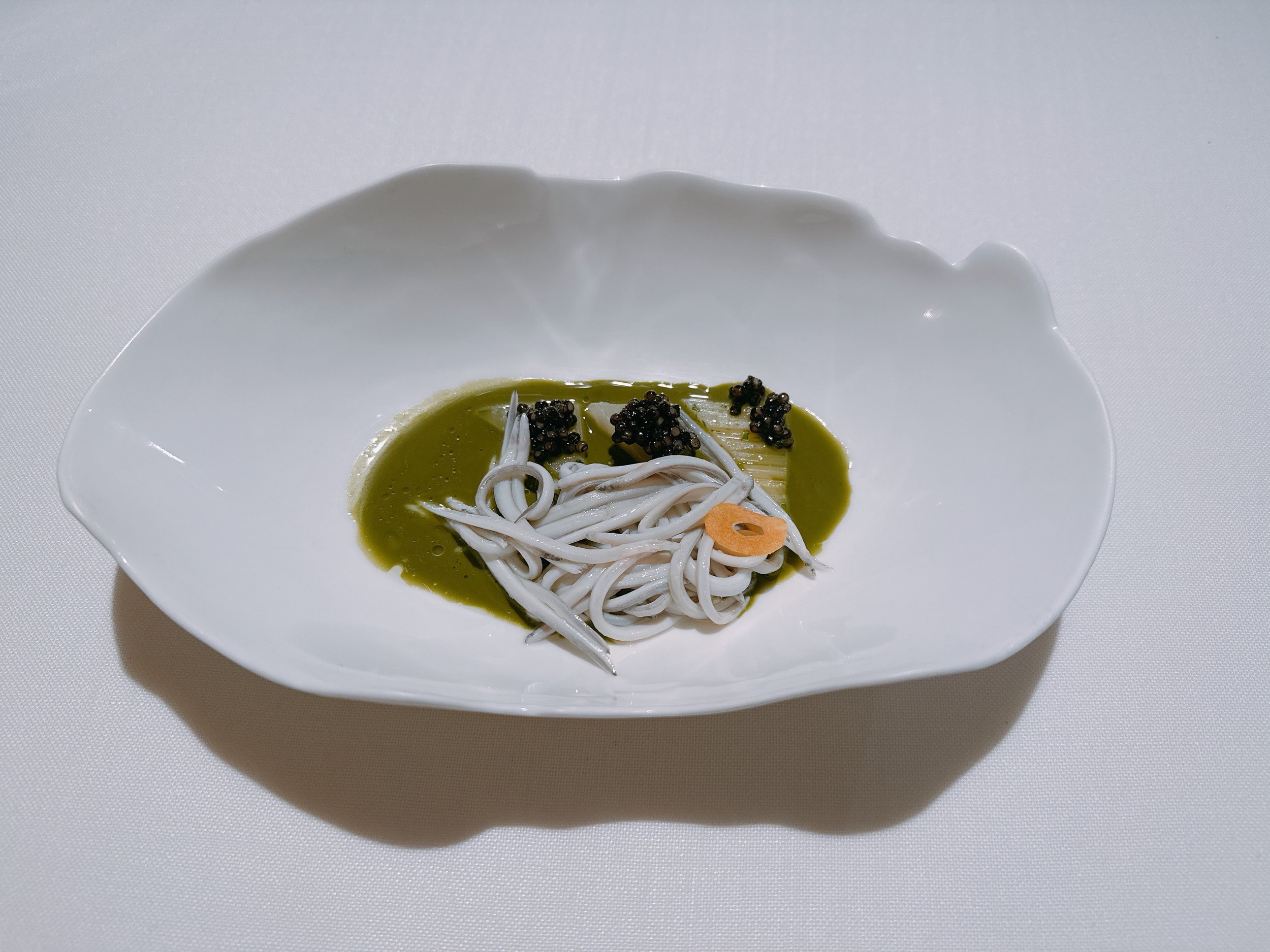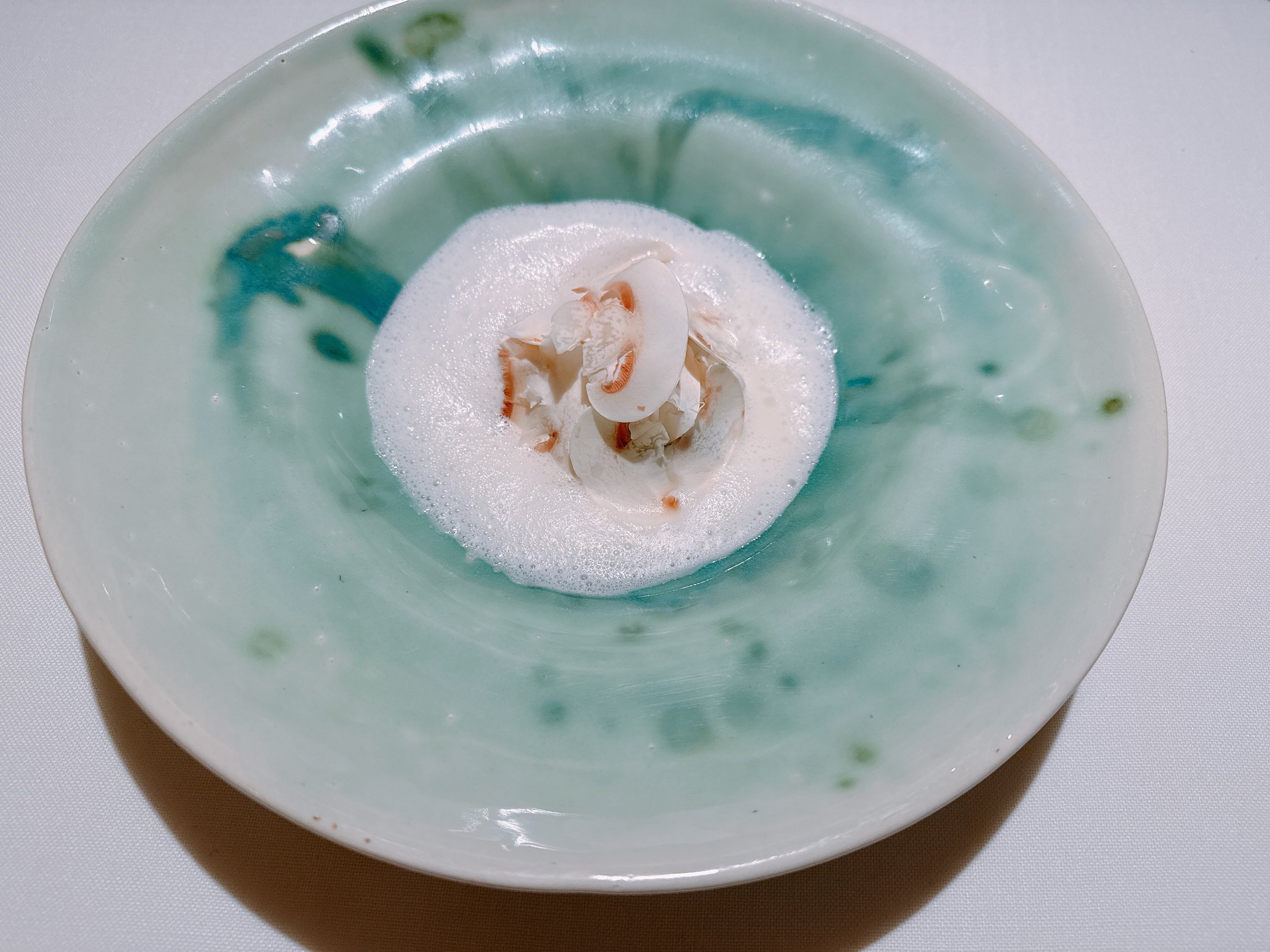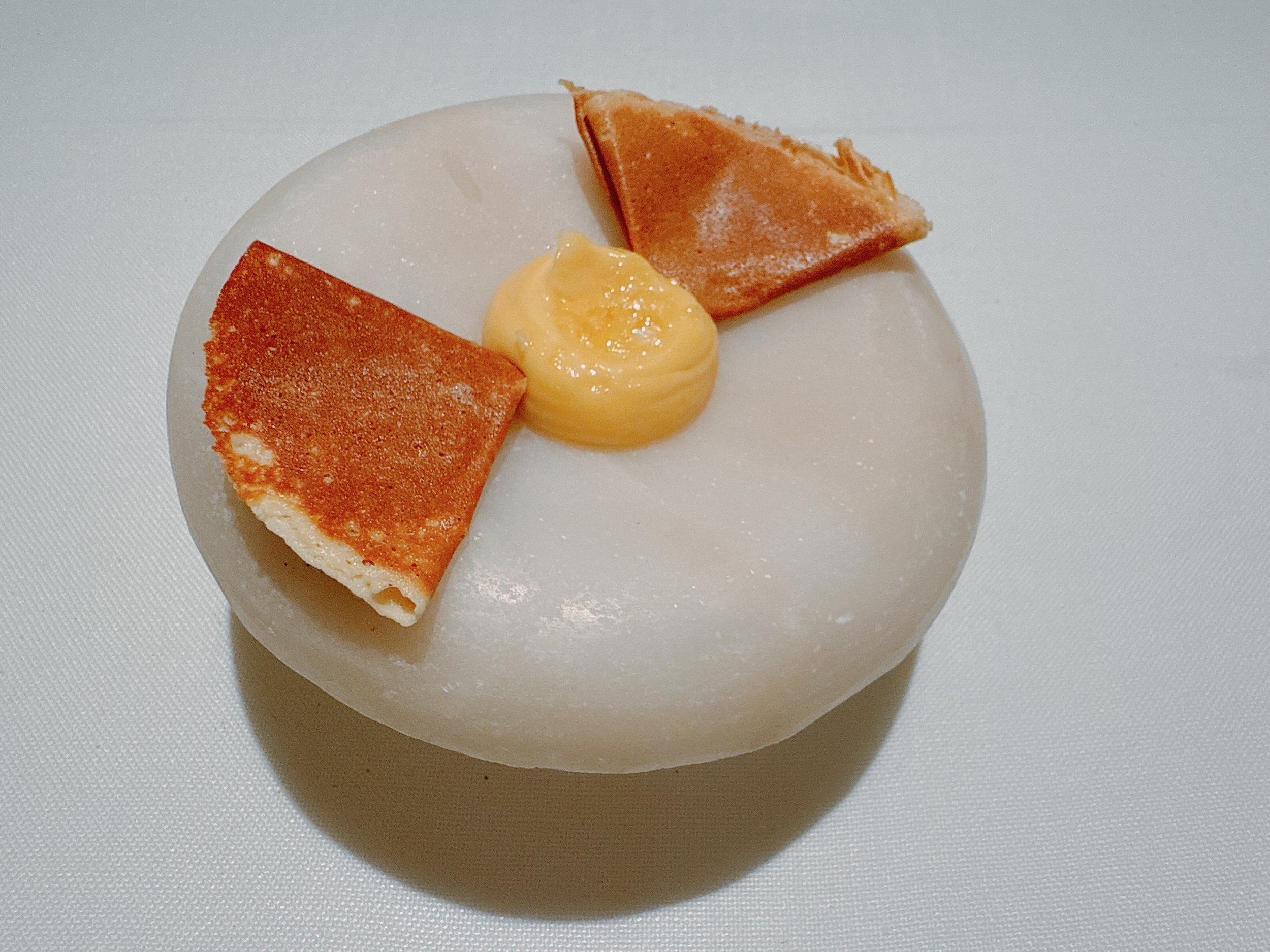Casa Marcial - Arriondas
Rating: 18/20
Where: Arriondas, Spain
When: Dinner for 2 on 6 December 2024
Cost per Person: Tasting menu 165-220 Euro, Wine pairing 90-119 Euro
Accolades: 3 Michelin Stars
Why: Creative cuisine reflecting the Asturias region of Spain, several phenomenal dishes
If one made a list of popular culinary destinations in Spain, San Sebastian and Barcelona would probably rank highly. Closely followed by Valencia, Madrid, and a wide range of other options. Spain's Northwest, though? Definitely more of a deep cut in terms of fine-dining. At least until November 2024 when Michelin found its latest three-star restaurant in Spain's Asturias region. Bounded by the Atlantic to the north, and featuring dramatic peaks in the south, it's a region of contrasts with a climate that is quite temperate by Spanish standards.
Saner people probably would have taken at least a weekend to visit newly three-starred “Casa Marcial”, and enjoyed its surroundings. In our case, though, we spent less than 24 hours in Spain. The closest commercial airport to the restaurant is in Oviedo, the capital of Asturias, but it mainly serves domestic flights. So for us it was actually more convenient to fly to Bilbao, followed by a 2 1/2 hour drive. We spent the night on the coast in Ribadesella, a resort town whose beach is enclosed on both sides by mountains, similar to San Sebastian - very pretty. The restaurant itself is about a half hour drive inland, ideally using the N-634 motorway. Google Maps in its infinite wisdom put us on tiny, twisty mountain roads instead, giving us slightly more near-death experiences before our dinner than we would have preferred.
Casa Marcial is located in the chef's childhood home, and the building has a bit of a rustic mountain hut charm. There were exposed walls made from mismatched stones, a wood-burning fire place, wooden ceiling beams and wooden floors. Together with this backdrop, the white table cloths and the wicker chairs created a level of elegance that would happily accommodate everything from jeans to a suit. There were two dining rooms with four tables each during our visit, but apparently more tables will be added during the busier spring and summer times. We seemed to be the only English-speaking guests during our visit, but that will surely change in the upcoming months. Our server, and even more so the sommelier, spoke good English.
The restaurant served two tasting menus, priced at 165 and 220 Euro, respectively, during our visit. (The three stars were already having an effect, though, with prices set to increase by 30 Euro each at the beginning of 2025. It looked like we got in just in time.) The shorter menu was mostly a subset of the longer one, and the choice between the two had to be made at reservation time - not an uncommon practice in Spain. Dietary restrictions were accommodated. The beverage pairing included not just wine, but also mead, a local cider, a sake and a house-made gin. It went well with the food - in a couple of cases even exceptionally well. And a few of the wines were even quite good on their own. Definitely recommended.
Our dinner started in a downstairs lounge, seated in front of a warm, crackling fireplace. With a glass of champagne in hand, we tackled our first few bites. It turned out that the aperitif wasn't really necessary, since we were also given a hot broth to sip on. The broth was made from cider and limpets (think: a kind of barnacle) and infused table-side with fresh limpets, sea lettuce and kombu. We were told that the restaurant’s philosophy was to reflect the local region, from the ocean to the mountains (and everything inbetween). In that context, this salty drink with a concentrated taste of the sea made total sense. For what it's worth, I couldn't really detect the cider among the strong seafood flavor, but the result was still very tasty. Unfortunately, also a bit hard to rate given its ostensible simplicity - maybe a 18.
On to the bites served with the broth. A ham croquette was crunchy on the outside and had a cheesy, creamy filling with some bacon bits. A nice, rustic treat, presumably a taste of home for the chef 15. The pescatarian alternative was a “scrambled egg” topped with onions and blue cheese. The egg had a crunchy consistency, making it kind of a light cracker - probably a good thing, since we had to eat it with our hands. Plus points for user friendliness. The dish had a light onion taste, but not much of a blue cheese flavor. Fine, but not too memorable 14.
The restaurant's version of boroña was cornbread topped with chorizo oil, cured pork and fermented cabbage. It was a bit sweet, mealy from the corn and acidic from the cabbage. Similar to the egg: fine, but not overly exciting 14. This time, the pescatarian alternative was slightly better. Sea urchin was served in its shell, and topped with a hollandaise sauce and pieces of apple and celery. The sea urchin had a surprisingly dark color and probably wasn't the best I've ever had, but with the creamy sauce that hardly mattered. The celery added some nice crunch to the dish, but I would have preferred the sea urchin to stand out more 15.
Our dinner continued in an upstairs dining room. We were served two dishes at the same time, and it was initially unclear whether they were meant to be eaten together or separately. Some scientific experimentation determined that one-at-a-time might be the better choice. So we started with a celery curd that came with seaweed, cucumbers and a grass granita. A light dish, but with solid flavors. It made one think of fields, herbs or a vegetable garden - an epitome of greenery 18. Alongside it came a lightly crunchy cracker that was filled with multiple purees - made of mussels, seaweed, parsley and codium. Sadly, it was hard to distinguish the tastes of the individual ingredients, and the dish was pretty salty 15.
Two kinds of breads were offered at this point. One was a sourdough bread made in nearby Arriondas: simple, rustic and crunchy. The other was a mixed corn and sourdough bread. Its consistency was more moist, and it was also a tad sweeter. No butter or other toppings were served, so the bread was mainly meant to sop up sauces - the sourdough for the earlier courses, and the cornbread for the latter part of our dinner 16.
Next came a dish featuring local mushrooms. Marinated milk cap mushrooms were served escabeche style, with a sweet roasted carrot, pine nuts, a foam made of local Vare cheese and petals of the hemerocallis flower. Our server claimed that the flower petals tasted of peach. While I couldn't really detect that, their texture was unusual: slightly juicy. The escabeche sauce was lovely and very flavorful, the carrot sweet, the pine nuts crunchy. So far, so good, The mushrooms however didn't have much innate taste and their texture was on the preserved side. It was odd that the first-billed ingredient wasn't more compelling 16. Interestingly, this dish was paired with a low altitude honey mead - the fact that our sommelier made a point to distinguish between low and high altitude honeys shows the role that they play in local culinary culture.
The following dish was based on baby eels, and I had an unfortunate deja vu. In a similar dish in the previous year, both of my dining companions were so grossed out by the ingredient that they refused to finish the course. Thankfully, this time, that was not a problem. The texture of the baby eels was similar to a buttery pasta, so one could almost think of this as a pasta dish. The eels came with celery slices, a chard puree, parsley, lemon, three dollops of caviar and a single slice of fried garlic. The celery had a light texture, but little noticeable taste, while the caviar was salty, intensifying the seafood and herbal flavors in the dish 17. A white Burgundy was a spot-on pairing where the tastes of both the dish and the wine were enhanced by each other.
A signature dish of the chef was a sliced hake, barely cooked and served with grilled green beans from the restaurant's garden, a pilpil sauce made from the essence of hake, and sliced white mushrooms on top. There was little not to like about this dish. The fish was fresh, and melted in one's mouth - it was prepared to a perfect, slightly translucent, consistency. The sliced crunchy beans were of great quality with an intense flavor, and added some crunch to an otherwise heavier dish. The sauce was strongly flavored - creamy, salty, foamy. An seemingly simple dish, but done to perfection 20.
During our drive in, we had already seen them grazing on lush grassy hillsides: blond Friesian cows. The next dish paired slices of raw beef from these local cows with a layer of bone marrow, a pickled salad and a seaweed butter sauce. The beef was nice and flavorful. Since the dish was fatty and buttery thanks to the other ingredients, it was good to have the pickles on hand to cut through the fat. The salty sauce enhanced the taste further. Our server claimed that the beef was a bit salty since it had been raised close to the sea, but I couldn't really taste it 18. The pescatarian menu replaced the beef with celery - a bit boring in comparison, although the sauce remained delightful 14.
A sous-vide cooked and briefly smoked trout was steamed at the table with a “river broth”, the latter made from mosses, ferns, mushrooms and roots. Some of that broth was served in a wine glass alongside the dish. The trout rested in a sauce made from toasted yeast, and was accompanied by a seeded cracker topped with a foam of beans and some local flowers. Starting with the broth, it was bursting with flavor: a bit mushroomy, a bit herbal, and quite salty. The trout had an amazing consistency: it was very fatty and melted in one's mouth. This was the trout equivalent of otoro, served warm. While trout's texture, with its fattiness and creaminess, was the first thing one noticed, there was also a fishy aftertaste, surprisingly strong for a trout - I might have preferred a tad less here, but I'm nitpicking. The yeast sauce was not that exciting by itself, and had a hard-to-place flavor, but it went great with the fish. The seedy cracker was crunchy and a bit fatty, but it was brightened up by its toppings, including cucumbers and a refreshing sauce 20.
More seafood followed. This time, sous-vide cooked slices of squid were served with an Mexican mole made from local black beans, a squid ink sauce and little pieces of SCOBY (the starter used to make kombucha). The squid had a firm texture, yielding a clean bite without being rubbery at all. But the stars of the dish were the excellent sauces. The mole was delicious - creamy and salty. The squid ink sauce had a good seafood flavor and a hint of spice. The black beans were tasty as well with a good texture. The acidic SCOBY was a good complement to the earthier sauces. Our server claimed that the SCOBY had a texture similar to the squid, but that seemed a bit of a stretch. I probably would have enjoyed the dish even without the squid, the rest of it was that good 18. This course was based on a traditional dish usually served with rice. To acknowledge that, it was paired with an aged sake that was a blend of the 1989 and 1999 vintages - very good even by itself.
Next came a salad course of sorts, presented in two parts. First, a salad made with tomatoes, a cucumber jelly, a vinegar ice cream and a granita made from fennel and celery. The dish was finished table-side with a liquid lettuce sauce. A very green dish: herbal, sweet, cold, with some texture from the herbs - yummy 18. Then, we were served a kind of lettuce cracker. Two dehydrated lettuce leaves with a seaweed pesto between them. The flavor was a bit unexpected: this dish didn't taste much of the lettuce or the pesto, it was primarily “just” sweet - the lettuce must have been candied during preparation. More interesting technique-wise than flavor-wise 16. This dish was paired with a red wine, which seemed an odd choice for a salad, and especially for the sweet cracker.
The last seafood course was a catch of the day, a filet of grouper. It was grilled and served with two sauces, a green herb cream and a white sauce made from clams, garlic and fish oil. On the side was a seaweed cracker topped with some lightly dressed herbs. The fish was fatty with a firm texture and a crispy skin. It had a strong aroma and a pronounced grill aroma. The sauces were amazing, with an intense combination of herbal and garlic flavors. The cracker was salty and lightly herbal, and the herbs on top were extremely fragrant. Ironically, the fish might have been the weakest part of an otherwise fresh, bright dish, but that's just nitpicking at a high level 19.
On to the meat courses. First up, a wild duck, marinated and served with a bone sauce. On its side was a “lactic foie gras”, a preparation of goat milk meant to resemble foie gras. It was topped with an anchovy, and there were also some small pickled onions on the plate. The duck was strongly flavored, almost reminiscent of bacon, lean and salty. This was a duck dish to convert people who don't like duck - one might eat it without being able to guess what kind of meat it was. The sauce was mostly savory but had a hint of sweetness as well. The fake foie gras tasted cheesy and peppery, so wasn't exactly a dead ringer for the real thing (and “no ducks were harmed in the making of this foie gras” seems a small consolation given the rest of the dish). The little onions added a bit of freshness and sweetness to an otherwise heavy dish 18. The pescatarian replacement was something entirely different: a “ravioli” made from cod skin - what an interesting idea! It was filled with eggplant, and came with trumpet mushrooms, walnuts, arugula, a cod milk sauce and coffee powder. The elastic outside of the ravioli, i.e. the cod skin, made for an unusual texture. Its filling was a bit sweet, the sauce creamy and a tad spicy, and the walnuts added some texture. It actually worked quite well - a very creative dish 18.
The final savory dish was a recipe handed down by the chef's mother, a “pitu de caleya”. In this instance, it was a rooster that had been slowly braised to a flaky consistency. It came with a sauce, two potato pillows and a cream of liver topped with the fried rooster's comb. Overall, this was a rustic dish, closer to home cooking than to fine dining, but still very well executed. The sauce was nice, savory and rustic, the offal sauce a bit too liver-heavy for my taste, and the comb had no flavor with a texture similar to popped chickpea chips 16. The pescatarian replacement was much more elegant. Grouper was served with a beurre blanc and pine nuts. The fish was cooked nicely, and while the beurre blanc was on the heavier / non-acidic side, it was still quite tasty. The pine nuts added some crunch and some sweetness 19.
The following palate cleanser was a combination of apple water jelly, sea urchin, a seawater foam and a water made from lemons, oranges, mint and seaweed. Altogether, this mostly tasted of apples, with a hint of bitterness and herbs. The sea urchin was merely texture. Ok as a palate cleanser, but otherwise a bit random: there were too many ingredients to tell a clear story 14. On the side were some rolls of fried nori filled with a sweet seaweed butter. A sweet cracker with a good seaweed flavor, it reminded me of being in Japan 17.
“Cereal skin” made from fresh cream had been thickened with rice flower, dusted with cinnamon and given the shape of a cow. Not that sweet and with a gooey texture, it was reminiscent of a mochi without the sugar. Sweeter might have been better 13.
Next came a folded crepe (fayuela) served with a sweet dip made from corn and cream. The crepe was actually quite crispy, with a texture more similar to a cracker. The dip was delicious, with some noticeable salt crystals. Hard to do this much better 19.
Another wintry dessert followed. It contained several components: a cream of beans and chestnuts, beans from the restaurant's garden cooked in a sweet syrup, a horseradish (!) ice cream, a green bean miso and a bean water foam. The texture here was a bit crunchy, but mostly mealy. The dish was not that sweet, with umami and a little (but not too much) spice from the horseradish. The taste didn't blow me away, but it was very creative to make a (non-Asian) dessert almost solely with beans 17.
The last dessert had milk skin over a toffee made from kefir. Next to it was a kefir ice cream drizzled with clover oil. The milk skin was delicious combined with the caramel, and had an interesting texture - gooey and creamy at the same time. The ice cream was sweet with a light crunch added by some crumbles underneath. Oddly, the ice cream's taste reminded me of hojicha. Another creative dessert 18. The paired beverage was a house-made gin on the basis of blue cheese. Truly unique: a strong blue cheese nose led to a light cheesy flavor note and a sweet taste.
We received two petit fours to conclude our meal. A hazelnut meringue topped with a caramelized hazelnut had an airy texture and an intense hazelnut flavor. We definitely appreciated having such a light bite after a long dinner, without having to compromise on the flavor intensity 19. A gummy made with honey sourced from the southern part of Asturias was sweet, but with neither the texture nor taste that I would have expected, in fact I wouldn't even have guessed honey as an ingredient 16.
Overall: A meal worth the proverbial special journey. We didn't know anything about Asturias before coming here, but were very happy to have made the trip. The modern food took inspiration from the landscape, from sea to mountains, and was consistently delicious, in many instances quite creative, and in a few cases truly spectacular. Add to that a friendly service, a great and sometimes surprising beverage pairing, and you have a clear winner 18.































